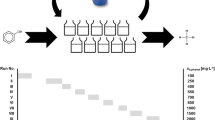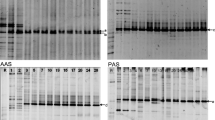Abstract
The microbial degradation of poly (3-hydroxyalkanoates) (PHAs) under anaerobic conditions with various terminal electron acceptors was examined. Nitrate-reducing consortia were established using activated sludge, and PHAs were shown to be biodegradable under these conditions. A positive correlation between carbon dioxide production and nitrate reduction was demonstrated. Nitrous oxide accumulated as the main N-containing product of nitrate reduction. The amount of PHAs in activated sludge cultures decreased approximately 20% within 40 days of incubation. Attempts were made to establish iron- and sulfate-reducing consortia from spring water, yet it could not be demonstrated that the mixed cultures were capable of degrading PHAs. Pure cultures of iron- and sulfate-reducing bacteria could not utilize PHAs as sole carbon sources. Methanogenic environments sampled included pond sediment and rumen fluid. PHAs were fermented to methane and carbon dioxide after 10 weeks by a sediment consortium, with 43 to 57% of the substrate carbon transformed to methane. Although it could not be demonstrated that PHAs were biodegraded by a rumen fluid consortium, a facultative anaerobic bacterium, identified as aStaphylococcus sp., that could grow on PHAs was isolated from rumen fluid.
Similar content being viewed by others

References
A. Steinbüchel (1991) in D. Byrom (Ed.),Biomaterials: Novel Materials from Biological Sources, Stockton Press, Macmillan, and ICI Biological Products, pp. 125–213.
H. Brandl, R. A. Gross, R. W. Lenz, and R. C. Fuller (1990)Adv. Biochem. Eng. Biotechnol. 41, 77–93.
A. J. Anderson and E. A. Dawes (1990)Microbiol. Rev. 54, 450–472.
J. K. Rogers (1992)Modern Plast. 69, 17.
F. P. Delafield, M. Doudoroff, N. J. Palleroni, C. J. Lusty, and R. Contopoulos (1965)J. Bacteriol. 90, 1455–1466.
K. Mukai, K. Yamada, and Y. Doi (1992)Int. J. Biol. Macromol. 14, 235–239.
K. Yamada, K. Mukai, and Y. Doi (1993)Int. J. Biol. Macromol. 15, 215–220.
A. Schirmer, D. Jendrossek, and H. G. Schlegel (1993)Appl. Environ. Microbiol. 59, 1220–1227.
T. Tanio, T. Fukui, Y. Shirakura, T. Saito, K. Tomita, T. Kaho, and S. Masamune (1982)Eur. J. Biochem. 124, 71–77.
Y. Shirakura, T. Fukui, T. Saito, Y. Okamoto, T. Narikawa, K. Koide, K. Tomita, T. Takemasa, and S. Masamune (1986)Biochim. Biophys. Acta 880, 46–53.
T. Fukui, T. Narikawa, K. Miwa, Y. Shirakura, T. Saito, and K. Tomita (1988)Biochim. Biophys. Acta 952, 164–171.
T. Saito, K. Suzuki, J. Yamamoto, T. Fukui, K. Miwa, K. Tomita, S. Nakanishi, S. Odani, J. I. Suzuki, and K. Ishikawa (1989)J. Bacteriol. 171, 184–189.
T. Saito, A. Iwata, and T. Watanabe (1993)J. Environ. Polym. Degrad. 1, 99–105.
J. Zhang, T. Saito, A. Ichikawa, and T. Fukui (1992)Chem. Pharm. Bull. 40, 713–717.
D. Jendrossek, I. Knoke, R. B. Habibian, A. Steinbüchel, and H. G. Schlegel (1993)J. Environ. Polym. Degrad. 1, 53–63.
K. Mukai, K. Yamada, and Y. Doi (1993)Polym. Degrad. Stabil. 41, 85–91.
K. Mukai, K. Yamada, and Y. Doi (1993)Int. J. Biol. Macromol. 15, 361–366.
Y. Doi, Y. Kanesawa, and M. Kunioka (1990)Macromolecules 23, 26–31.
Y. Kumagai, Y. Kanesawa, and Y. Doi (1992)Makromol. Chem. 193, 53–57.
H. Nishida and Y. Tokiwa (1993)J. Environ. Polym. Degrad. 1, 65–80.
J. Mergaert, A. Webb, C. Anderson, A. Wouters, and J. Swings (1993)Appl. Environ. Microbiol. 59, 3233–3238.
L. Lopez-Llorca, M. F. Colom Valiente, and A. Gascon (1993)Micron 24, 23–29.
B. H. Briese, D. Jendrossek, and H. G. Schlegel (1994)FEMS Microbiol. Lett. 117, 107–112.
D. F. Gilmore, S. Antoun, R. W. Lenz, and R. C. Fuller (1993)J. Environ. Polym. Degrad. 1, 269–274.
D. F. Gilmore, S. Antoun, R. W. Lenz, S. Goodwin, R. Austin, and R. C. Fuller (1992)J. Indust. Microbiol. 10, 199–206.
M. Matavulj and H. P. Molitoris (1992)FEMS Microbiol. Rev. 103, 323–332.
J. Mergaert, C. Anderson, A. Wouters, J. Swings, and K. Kersters (1992)FEMS Microbiol. Rev. 103, 317–322.
Y. Doi, Y. Kanesawa, N. Tanahashi, and Y. Kumagai (1992)Polym. Degrad. Stabil. 36, 173–177.
L. Lopez-Llorca, M. F. Colom Valiente, and M. J. Carcases (1994)Micron 25, 45–51.
H. Brandl and P. Püchner (1990) in E. A. Dawes (Ed.),Novel Biodegradable Microbial Polymers, Kluwer Academic, Dordrecht, The Netherlands, pp. 421–422.
M. Matavulj, S. T. Moss, and H. P. Molitoris (1993) in H. G. Schlegel and A. Steinbüchel (Eds.),Proceedings of the International Symposium on Bacterial Polyhydroxyalkanoates, Goltze-Druck, Göttingen, Germany, pp. 465–466.
P. H. Janssen and C. G. Harfoot (1990)Arch. Microbiol. 154, 253–259.
J. Urmeneta, J. Mas-Castellá, and R. Guerrero (1995)Appl. Environ. Microbiol. 61, 2046–2048.
A. C. Palmisano, D. A. Maruscik, and S. S. Schwab (1993)J. Gen. Microbiol. 139, 387–391.
K. Budwill, P. M. Fedorak, and W. J. Page (1992)Appl. Environ. Microbiol. 58, 1398–1401.
W. J. Page and O. Knosp (1989)Appl. Microbiol. Biotechnol. 55, 1334–1339.
W. J. Page, J. Manchak, and B. Rudy (1992)Appl. Environ. Microbiol. 58, 2866–2873.
J. H. Law and R. A. Slepecky (1961)J. Bacteriol. 82, 33–36.
I. D. Bossert, M. D. Rivera, and L. Y. Young (1986)FEMS Microbiol. Ecol. 38, 313–319.
P. M. Fedorak and D. Grbić-Galić (1991)Appl. Environ. Microbiol. 57, 932–940.
M. D. Collins and F. Widdel (1986)Syst. Appl. Microbiol. 8, 8–18.
J. R. Postgate (1979)The Sulphate-Reducing Bacteria, Cambridge University Press, Cambridge.
D. R. Lovley, E. J. P. Phillips, and D. J. Lonergan (1989)Appl. Environ. Microbiol. 55, 700–706.
D. R. Lovley and E. J. P. Phillips (1988)Appl. Environ. Microbiol. 54, 1472–1480.
D. R. Lovley and E. J. P. Phillips (1986)Appl. Environ. Microbiol. 51, 683–689.
E. E. Roden and D. R. Lovley (1993)Appl. Environ. Microbiol. 59, 734–742.
C. O. Obuekwe, D. W. S. Westlake, and F. D. Cook (1981)Can. J. Microbiol. 27, 692–697.
P. M. Fedorak and S. E. Hrudey (1984)Water Res. 18, 361–367.
P. M. Fedorak and S. E. Hrudey (1983)Environ. Technol. Lett. 4, 425–432.
B. A. Ramsay, J. A. Ramsay, and D. G. Cooper (1989)Appl. Environ. Microbiol. 55, 584–589.
C. W. Dunnett (1955)Am. Stat. Assoc. J. 50, 1096–1121.
R. G. D. Steel and J. H. Torrie (1980)Principles and Procedures of Statistics. A Biometric Approach, 2nd ed., McGraw-Hill, New York.
J. M. Tiedje (1988) in A. J. B. Zehnder (Ed.),Biology of Anaerobic Microorganisms, John Wiley & Sons, New York, pp. 179–244.
T. J. Dichristina and E. F. Delong (1994)J. Bacteriol. 176, 1468–1474.
D. R. Lovley, S. J. Giovannoni, D. C. White, J. E. Champine, E. J. P. Phillips, Y. A. Gorby, and S. Goodwin (1993)Arch. Microbiol. 159, 336–344.
E. A. Dawes and P. J. Senior (1973)Adv. Microb. Physiol. 10, 135–266.
F. Widdel (1988) in A. J. B. Zehnder (Ed.),Biology of Anaerobic Microorganisms, Wiley, New York, pp. 469–586.
P. M. Fedorak, K. M. Semple, and D. W. S. Westlake (1987)J. Microbiol. Methods 7, 19–27.
T. J. Galvin (1990) in S. A. Barenberg, J. L. Brash, R. Narayan, and A. E. Redpath (Eds.),Degradable Materials: Perspectives, Issues and Opportunities, CRC Press, Boca Raton, FL, pp. 39–43.
A. M. Buswell and H. F. Mueller (1952)Ind. Eng. Chem. 44, 550–552.
Author information
Authors and Affiliations
Rights and permissions
About this article
Cite this article
Budwill, K., Fedorak, P.M. & Page, W.J. Anaerobic microbial degradation of poly (3-hydroxyalkanoates) with various terminal electron acceptors. J Environ Polym Degr 4, 91–102 (1996). https://doi.org/10.1007/BF02074870
Issue Date:
DOI: https://doi.org/10.1007/BF02074870



